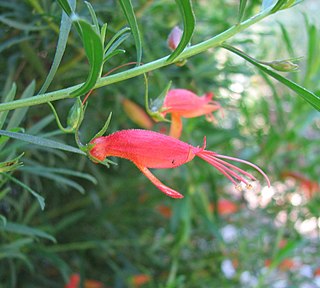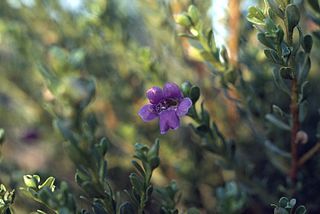
Eremophila oldfieldii, commonly known as pixie bush, is a flowering plant in the figwort family, Scrophulariaceae and is endemic to Western Australia. It is a shrub or small tree with rough bark, broad, flat or narrow fleshy leaves and red, orange or yellow flowers.

Eremophila decipiens, commonly known as slender fuchsia bush or narrow-leaved fuchsia bush is a flowering plant in the figwort family, Scrophulariaceae and is endemic to an area extending from the south-west of Western Australia to southern parts of South Australia. It is low, sprawling shrub with lance-shaped leaves and red, orange or yellow flowers on a long, S-shaped stalk.
Diocirea is a genus of flowering plants in the figwort family, Scrophulariaceae. The genus is endemic to a small area in the south-west of Western Australia and is intermediate in character between Eremophila and Myoporum. There are four members of the genus, all of which are small shrubs with stems and leaves which produce a resin making the plants appear bluish-green. Neither the genus, nor any of the species had been described before 2007 although a few specimens had been collected as Eremophila elachantha. Despite their limited distribution, they often occur in populations of several thousand individual plants, forming a dense ground cover.

Myoporum velutinum is a plant in the figwort family, Scrophulariaceae and is endemic to a small area near Esperance in Western Australia. It has similar flowers and fruits and grows in similar environments to Myoporum tetrandrum but differs from it and all other members of the genus by having hairs on the outer edge of the petals.

Calamphoreus inflatus is the only species of the flowering plant genus Calamphoreus in the family Scrophulariaceae. It is a shrub, formerly known as Eremophila inflata but unlike eremophilas, this species has twisted stamens and an urn-shaped petal tube which remains attached to the fruits after flowering.
Diocirea acutifolia is a plant in the figwort family, Scrophulariaceae and is endemic to a small area near Norseman in Western Australia. The branches and leaves produce sticky resin which sometimes covers the whole plant making it appear bluish grey. This species is distinguished from the three others in the genus by its leaves which are longer than 6 millimetres (0.2 in) and the prominent resin glands on its stems.
Diocirea ternata is a plant in the figwort family, Scrophulariaceae and is endemic to a small area near Balladonia in Western Australia. It is a low shrub with a restricted distribution but which often occurs in large numbers, forming a dense ground cover. It is readily distinguished from the other three species in the genus by its unusual leaf arrangement.
Diocirea violacea is a plant in the figwort family (Scrophulariaceae), and is endemic to a small area near Salmon Gums in Western Australia. It is a low shrub with a restricted distribution but which often occurs in large numbers, forming a dense ground cover. It can be distinguished from the three others in its genus by a combination of the size and arrangement of its leaves and the appearance of its fruits.
Eremophila appressa, commonly known as wispy poverty bush, is a plant in the figwort family, Scrophulariaceae and is endemic to two remote locations in the central west of Western Australia. Its most unusual feature is its leaves which, at least when young, are less than 2.5 mm (0.1 in) long and 1 mm (0.04 in) wide and are glued to the stem by resin.
Eremophila ciliata, commonly known as Archer's eremophila is a flowering plant in the figwort family, Scrophulariaceae and is endemic to a small area in the south of Western Australia. It is an erect, spreading shrub with short, thick leaves and small lilac to mauve flowers. It is only known from a population of about 100 plants.
Eremophila eversa is a flowering plant in the figwort family, Scrophulariaceae and is endemic to a restricted area of Western Australia. It is known from only one plant, now thought to have died. It is a small shrub with small leaves and hairy purple to lilac-coloured flowers.

Eremophila granitica, commonly known as granite poverty bush and thin-leaved poverty bush is a flowering plant in the figwort family, Scrophulariaceae and is endemic to Western Australia. It is an erect, open shrub with sticky, narrow leaves and with lilac-coloured flowers.

Eremophila lucida, commonly known as shining poverty bush, is a flowering plant in the figwort family, Scrophulariaceae and is endemic to Western Australia. It is an erect shrub with sticky, shiny leaves and branches and with flowers that are either red with darker red blotches inside or cream-coloured without spots or blotches.
Eremophila pallida is a flowering plant in the figwort family, Scrophulariaceae and is endemic to Western Australia. It is a small, spreading shrub with hairy stems, leaves with a few serrations and reddish purple to violet flowers.

Eremophila platythamnos, commonly known as desert foxglove, is a flowering plant in the figwort family, Scrophulariaceae and is endemic to Australia. It is an erect shrub with short, broad leaves and purple, mauve, blue or pink flowers.

Eremophila reticulata is a flowering plant in the figwort family, Scrophulariaceae and is endemic to Western Australia. It is a dense shrub with egg-shaped leaves, colourful sepals and white or pink flowers.

Eremophila rugosa is a flowering plant in the figwort family, Scrophulariaceae and is endemic to Western Australia. It is an erect shrub with sticky, shiny leaves and pink, purple or mauve flowers.

Eremophila serpens, commonly known as snake eremophila, is a flowering plant in the figwort family, Scrophulariaceae and is endemic to Western Australia. It is a prostrate, creeping shrub with long, horizontal branches, leaves which often have irregular serrations, and yellowish-green petals with red or brownish-purple markings.

Eremophila veronica, commonly known as veronica-like eremophila, is a flowering plant in the figwort family, Scrophulariaceae and is endemic to Western Australia. It is a low, spreading shrub with small, crowded leaves and lilac-coloured flowers which have a short petal tube and spreading petal lobes.
Eremophila verticillata, commonly known as whorled eremophila, is a flowering plant in the figwort family, Scrophulariaceae and is endemic to Western Australia. It is a low, spreading or rounded shrub with a strong odour, small leaves pressed against the stem and purple flowers. It is a rare plant, partly due to land clearing.












